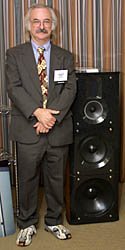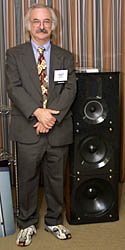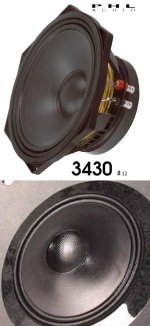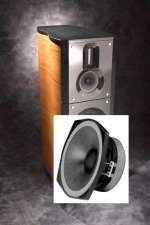Good pictures of Rushmore are now on the website, and also the spec sheet (pdf) . The spec sheet is a good read, and has lots of information on the speakers, along with the philosophy behind them.
They definately look like PHL audio drivers along with the Raven.
from the spec sheet (pdf):
"The result is a four-way system, with a 15 inch
deep bass driver, a 10 inch mid bass driver, and
6 inch midrange, and a ribbon tweeter. The bass
driver is 97 dB/watt efficient, and the remaining
drivers are at least 98 dB/watt. The cone drivers
are all high quality professional drivers rated at
high wattage levels which by coincidence work
very well together. As a group, they were the
best we could find."
Looking at the PHL website, the drivers look like these:
Ribbon tweeter: Raven 2
6.5" midrange: 1140/1080 or 1160
10" midwoofer: 3840 or 3430
15" woofer: 6030 or 5010
They look great and definately a great direction for speakers to be going, towards greater efficency and response.
--
Brian
They definately look like PHL audio drivers along with the Raven.
from the spec sheet (pdf):
"The result is a four-way system, with a 15 inch
deep bass driver, a 10 inch mid bass driver, and
6 inch midrange, and a ribbon tweeter. The bass
driver is 97 dB/watt efficient, and the remaining
drivers are at least 98 dB/watt. The cone drivers
are all high quality professional drivers rated at
high wattage levels which by coincidence work
very well together. As a group, they were the
best we could find."
Looking at the PHL website, the drivers look like these:
Ribbon tweeter: Raven 2
6.5" midrange: 1140/1080 or 1160
10" midwoofer: 3840 or 3430
15" woofer: 6030 or 5010
They look great and definately a great direction for speakers to be going, towards greater efficency and response.
--
Brian
Attachments
Interesting and impressing product as well as reading of the info at Passlabs.
Justy one little thing . In the text it can be read that there is no such thing as a pistonic loudspeaker (or something like that).
. In the text it can be read that there is no such thing as a pistonic loudspeaker (or something like that).
Now, this is far from the truth. There are serious stiff coned bass drivers out there with low distortion motors and breakup frequency of 1-3kHz. TCsounds, AuraSounds and Seas Excel comes to mind. The Seas Excel W26 is a 10"er with FS 20Hz and break up at 3-4k or so.
Midwoofers and mids (8" to 2") from Accuton and Seas with stiff cones with break up points at 3-8k makes pistonic mids a piece of cake.
Focal soon (I think?) has their beryllium drivers on the market, seems to be interesting drivers.
For the highs there are several domes/inverted domes that is pistonic up to 50-100k or so.
So... no problem with designing a 10Hz-100kHz true pistonic loudspeaker for the person that feels for it
/Peter
Justy one little thing
Now, this is far from the truth. There are serious stiff coned bass drivers out there with low distortion motors and breakup frequency of 1-3kHz. TCsounds, AuraSounds and Seas Excel comes to mind. The Seas Excel W26 is a 10"er with FS 20Hz and break up at 3-4k or so.
Midwoofers and mids (8" to 2") from Accuton and Seas with stiff cones with break up points at 3-8k makes pistonic mids a piece of cake.
Focal soon (I think?) has their beryllium drivers on the market, seems to be interesting drivers.
For the highs there are several domes/inverted domes that is pistonic up to 50-100k or so.
So... no problem with designing a 10Hz-100kHz true pistonic loudspeaker for the person that feels for it
/Peter
Kent,
The .pdf says 100db @ 1 meter @ 1 volt
Is that right or is it @ 1 watt?
Also it says "professional" drivers, I take it that means pro sound drivers. Did you guys have them made to spec or are they off the shelf? PSL?
By the way your welcome to bring a pair along if you come to Tucson ;-)
Russ
The .pdf says 100db @ 1 meter @ 1 volt
Is that right or is it @ 1 watt?
Also it says "professional" drivers, I take it that means pro sound drivers. Did you guys have them made to spec or are they off the shelf? PSL?
By the way your welcome to bring a pair along if you come to Tucson ;-)
Russ
russbryant said:The .pdf says 100db @ 1 meter @ 1 volt
Is that right or is it @ 1 watt?
The amps are built in so 1 V from the pre-amp gooses the amps enuff so that the speakers generate 100dB
dave
BrianGT said:from the spec sheet (pdf):
"The result is a four-way system, with a 15 inch
deep bass driver, a 10 inch mid bass driver, and
6 inch midrange, and a ribbon tweeter. The bass
driver is 97 dB/watt efficient, and the remaining
drivers are at least 98 dB/watt. The cone drivers
are all high quality professional drivers rated at
high wattage levels which by coincidence work
very well together. As a group, they were the
best we could find."
It sounds like the drivers integrate together as well as Nelson's suit and shoes.

Attachments
russbryant said:Also it says "professional" drivers, I take it that means pro sound drivers. Did you guys have them made to spec or are they off the shelf? PSL?
They look just like PHL drivers. Look at the pdfs on the phl audio website. Here is a comparison from the pdf from PHL and the pictures from passlabs.com
--
Brian
Attachments
Nelson Pass said:You should have figured out by now that we always
hold a few cards in reserve to keep it interesting.

Indeed you do. How come you call the amplifer driving the 15" driver an Aleph X instead of sticking to the XA nomenclature, such as XA80?
from pdf:
"The bottom end is powered by an Aleph X
balanced single-ended Class A amplifier, a cousin
of the newly released Pass XA series."
Looks great. I really like the use of the granite and nice woods. It sure beats all of the "monkey casket" speakers.
--
Brian
Banned
Joined 2002
I think the Rushmore design concept is something we as followers of Mr Pass should all admire and we should respect the way his team has gone about it and executed the system.
Its fresh and melds art, science and good taste.
I idea of bi amping is not new, but its the skill and ideas behind the bringing the whole system together that impresses.
Remember this is a new product from Passlabs, and there are potentially thousands of hours been poured into the Rushmore, with countless layers of attention to details that create the finished product.
So as members of this forum we should admire this creation and see if we are up to the challenge of creating our own "original works" on that basis, rather than be tempted to crudely copy the work a great master.
Ian
Its fresh and melds art, science and good taste.
I idea of bi amping is not new, but its the skill and ideas behind the bringing the whole system together that impresses.
Remember this is a new product from Passlabs, and there are potentially thousands of hours been poured into the Rushmore, with countless layers of attention to details that create the finished product.
So as members of this forum we should admire this creation and see if we are up to the challenge of creating our own "original works" on that basis, rather than be tempted to crudely copy the work a great master.
Ian
russbryant said:So Pan, how exactly can it remain pistonic yet breakup?
Russ
Well, if a driver breaks up at 3kHz for instance and the driver is X-ed at 100Hz (low pass of course) then I think we can assume that the break up resonance will never be excited.
Hence it is possible to design a multiway speaker that operates with pistonic motion in the passband of every driver in the system.
/Peter
Peter,
You are correct, by deliberately limiting the stop band of a driver operating in its piston range, you can create of pure piston range system, this is the basis of my own system.
The issue of piston range/cone beak up is not a simple matter and relys on several factors, referance should be made to two excellent articles by Lynn Olsen as I recall. (called Looking over My Shoulder)
From some engineeing notes of a Speaker Building course I attended some time back run (by Mr Doug Tipping who is now a retired engineer and designs and makes his own superb drivers):
Reference is made to radiated power, the sound power (Pa) is developed in the radiation resistance (ra) portion of the air load. The power can be calculated using the formula, power = velocity squared times the radiation resistance.
(Pa = V2Ra)
Assuming the applied force is independant of frequency, we can calculate that radiated power is constant below " f1 ", and falls at 6db / Octave above f1.
Piston Range:
From this we can conclude that a rigid cone is desirable below "f1"
, but of no use at higher frequencies. Operation below "f1" is referred to mass controlled or "Piston" range. Outptut above f1 becomes very directional, and may rise on axis.
Response above piston range:
As the cone has mass, and cannot be infinitely rigid, there is a time delay between motion at the driven part of cone and motion at the cone edge. This has little importance at low frequencies, but at high frequencies it produces ripples in the cone which travel outward. Much like water when a stone is dropped into it.
Controlled Cone Flexure:
It was show above f1, a rigid cone will have a falling frequency response. By controlling the flexing of the cone, both the effective radiating area and moving mass can be reduced. This has the effects of extending the high frequency response well above f1, and improving the directional characteristics.
Voice Coil Mass:
The area/mass reducing characteristic will operate until the voice coil mass becomes the controlling factor. This is non reducible, and high frequency output will fall rapidly above this. With the correct cone material and profile, and a low mass coil assembly, a single cone loudspeaker can cover the full audio range. All full - range and most mid range louspeakers must operate beyond f1 whereas bass units can operate in purely mass controlled piston range.
The above is by no means a complete coverage of the topic (I'd be here for days) but forms a frame work of understanding from the engineering/physics perspective which all louspeakers operat e under being two stage energy converters: Electrical-Mechanical-Acoustical.
Cheers
Ian
You are correct, by deliberately limiting the stop band of a driver operating in its piston range, you can create of pure piston range system, this is the basis of my own system.
The issue of piston range/cone beak up is not a simple matter and relys on several factors, referance should be made to two excellent articles by Lynn Olsen as I recall. (called Looking over My Shoulder)
From some engineeing notes of a Speaker Building course I attended some time back run (by Mr Doug Tipping who is now a retired engineer and designs and makes his own superb drivers):
Reference is made to radiated power, the sound power (Pa) is developed in the radiation resistance (ra) portion of the air load. The power can be calculated using the formula, power = velocity squared times the radiation resistance.
(Pa = V2Ra)
Assuming the applied force is independant of frequency, we can calculate that radiated power is constant below " f1 ", and falls at 6db / Octave above f1.
Piston Range:
From this we can conclude that a rigid cone is desirable below "f1"
, but of no use at higher frequencies. Operation below "f1" is referred to mass controlled or "Piston" range. Outptut above f1 becomes very directional, and may rise on axis.
Response above piston range:
As the cone has mass, and cannot be infinitely rigid, there is a time delay between motion at the driven part of cone and motion at the cone edge. This has little importance at low frequencies, but at high frequencies it produces ripples in the cone which travel outward. Much like water when a stone is dropped into it.
Controlled Cone Flexure:
It was show above f1, a rigid cone will have a falling frequency response. By controlling the flexing of the cone, both the effective radiating area and moving mass can be reduced. This has the effects of extending the high frequency response well above f1, and improving the directional characteristics.
Voice Coil Mass:
The area/mass reducing characteristic will operate until the voice coil mass becomes the controlling factor. This is non reducible, and high frequency output will fall rapidly above this. With the correct cone material and profile, and a low mass coil assembly, a single cone loudspeaker can cover the full audio range. All full - range and most mid range louspeakers must operate beyond f1 whereas bass units can operate in purely mass controlled piston range.
The above is by no means a complete coverage of the topic (I'd be here for days) but forms a frame work of understanding from the engineering/physics perspective which all louspeakers operat e under being two stage energy converters: Electrical-Mechanical-Acoustical.
Cheers
Ian
In this area, when a shoeshine boy picks up my shoes for polishing, he gives me a pair of slippers for waiting. Probably, it would be the same in Las Vegas. The shoeshine boy however seemed to have respected Nelson Pass...relder said:
It sounds like the drivers integrate together as well as Nelson's suit and shoes.
JH
Pan said:Justy one little thing. In the text it can be read that there is no such thing as a pistonic loudspeaker (or something like that).
Now, this is far from the truth.
So... no problem with designing a 10Hz-100kHz true pistonic loudspeaker for the person that feels for it
/Peter [/B]
Absolutely correct, Peter, and Nelson should correct his brochure, forthwith, in case this casts any doubts on the accuracy of any of his other comments!

It just shows that you cannot trust what these 'New Boys' on the audio scene have to say, doesn't it?
Nelson, I'll teach you to threaten us with coupling caps in the new SOZ circuits!!!!!
What about the KEF B139 (13" X 9") driver, which was so popular some years ago in some of the high-end UK speakers, especially transmission lines?
If that particular driver didn't act like a true piston, and up to about 350Hz, then I am a monkey's uncle.

The diaphragm was a rigid, flat-fronted, expanded polystyrene slab about 1.5" deep at its thickest part at the centre, and if anyone could encourage that to flex or break-up, then I don't know who!
Trouble was that being a bit 'massy', it was in my view a rather slower piston than I would have preferred, but I did make several quite good-sounding speakers using the KEF B139s.
What really interested me in the literature, was the statement that the 'X' factor was deliberately only used in the bass section, and not in any of the higher frequency amps.
I am no 'X' eXpert
It makes me wonder just how important 'X' really is?

Regards,
Bobken
"It just shows that you cannot trust what these 'New Boys' on the audio scene have to say, doesn't it?"
Maybe I´m a bit slow here but what´ya mean?
I don´t know about that KEF driver you mention, you mean it was
a " bad" pistonic driver?
Also, of course it´s possible to make both a good and bad driver with stiff cone.
"I am no 'X' eXpert ( ), but believing that the 'X' factor was all about reducing distortions, I would have guessed that this would have been at least as important, if not more so, in the upper regions.
It makes me wonder just how important 'X' really is? "
Me too... not being an "X-pert" but also wondering why only in the bass. I would have guessed all four drivers or at least the three lower drivers. I think I remember reading somewhere.... sometime... long, long ago.... that Mr Nelson liked X amps for bass and mid and Aleph for a Raven in top.
but also wondering why only in the bass. I would have guessed all four drivers or at least the three lower drivers. I think I remember reading somewhere.... sometime... long, long ago.... that Mr Nelson liked X amps for bass and mid and Aleph for a Raven in top.
Or.... was it maybe X amp to the Volt woofer and Aleph to the mid AND highs?
Please enlighten us Nelson
/Peter
"It just shows that you cannot trust what these 'New Boys' on the audio scene have to say, doesn't it?"
Maybe I´m a bit slow here but what´ya mean?
I don´t know about that KEF driver you mention, you mean it was
a " bad" pistonic driver?
Also, of course it´s possible to make both a good and bad driver with stiff cone.
"I am no 'X' eXpert ( ), but believing that the 'X' factor was all about reducing distortions, I would have guessed that this would have been at least as important, if not more so, in the upper regions.
It makes me wonder just how important 'X' really is? "
Me too... not being an "X-pert"
Or.... was it maybe X amp to the Volt woofer and Aleph to the mid AND highs?
Please enlighten us Nelson
/Peter
I believe the attraction of different amp topologies for different speakers was in the designers' ability to cherry-pick the best amp for for a given part part of the spectrum. As the X amps are observed to be excellent performers in the LF region they are utilized for bass, while the Aleph circuits are used for the mids and highs where thay are known to excel.
I don't believe it negates the validity of the X circuit. Its really the whole idea behind multi-amping. Having heard the Rushmores at CES I can tell you the concept works to very nice effect!
Incidentally, I'm certain no driver available works as a perfect piston. Relatively speaking, there's an enormous amount of slop in the system with energy being lost in any number of directions.
Mike
I don't believe it negates the validity of the X circuit. Its really the whole idea behind multi-amping. Having heard the Rushmores at CES I can tell you the concept works to very nice effect!
Incidentally, I'm certain no driver available works as a perfect piston. Relatively speaking, there's an enormous amount of slop in the system with energy being lost in any number of directions.
Mike
planet10 said:
The amps are built in so 1 V from the pre-amp gooses the amps enuff so that the speakers generate 100dB
dave
Yeah, I guess I'm not used to thinking about active speakers.
Thanks,
Russ
- Status
- This old topic is closed. If you want to reopen this topic, contact a moderator using the "Report Post" button.
- Home
- Amplifiers
- Pass Labs
- The Unvailing of the ???? at the CES




